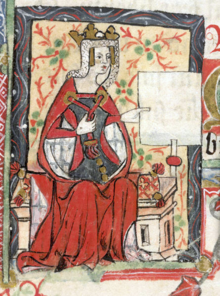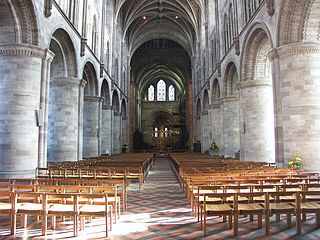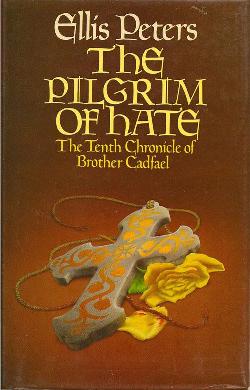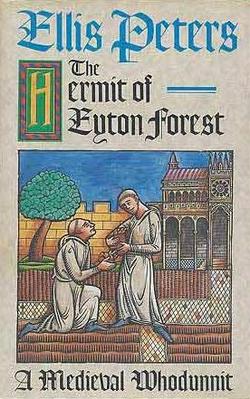
The 12th-century ruler Empress Matilda has been depicted in various cultural media.

The 12th-century ruler Empress Matilda has been depicted in various cultural media.
Matilda is a character in Henry I of England, a play by Beth Flintoff, which was first performed in November 2016 at St James's Church, Reading. [1] [2] The drama follows the story of the three sons of William the Conqueror and ends with the early reign of her father Henry, including the time when Matilda became Empress by marrying Henry V of Germany. The narrative continues in Flintoff's play Matilda the Empress, first performed in 2017 at the same venue with Dani McCallum taking the lead part. It depicts Matilda's later life and The Anarchy period after Henry I's death when she and her cousin Stephen were rivals for the succession. [3] [4] In the concluding part of Flintoff's trilogy, Henry II, which was first performed in October 2018 at Reading's Minster Church of St Mary the Virgin, Matilda is depicted attending the dedication of Reading Abbey over the Easter weekend of 1164. [5] [6]
Matilda is also a character in Jean Anouilh's play Becket . In the 1964 film adaptation, she was portrayed by Martita Hunt. [7] Alison Pill portrayed Matilda in the 2010 TV miniseries The Pillars of the Earth , an adaptation of Follett's novel. She was played by Brenda Bruce in the 1978 BBC TV series The Devil's Crown , which dramatised the reigns of her son and grandsons. [8]
Novels dealing with the civil war between Matilda and Stephen include:

Empress Matilda, also known as Empress Maud, was one of the claimants to the English throne during the civil war known as the Anarchy. The daughter and heir of Henry I, king of England and ruler of Normandy, she went to Germany as a child when she was married to the future Holy Roman Emperor Henry V. She travelled with the emperor to Italy in 1116, was controversially crowned empress in St Peter's Basilica, and acted as the imperial regent in Italy. Matilda and Henry V had no children, and when he died in 1125, the imperial crown was claimed by his rival Lothair of Supplinburg.

The Anarchy was a civil war in England and Normandy between 1138 and 1153, which resulted in a widespread breakdown in law and order. The conflict was a war of succession precipitated by the accidental death of William Adelin who had drowned in the White Ship disaster of 1120. Henry sought to be succeeded by his daughter, known as Empress Matilda, but was only partially successful in convincing the nobility to support her. On Henry's death in 1135, his nephew Stephen of Blois seized the throne, with the help of Stephen's brother Henry of Blois, who was the bishop of Winchester. Stephen's early reign saw fierce fighting with disloyal English barons, rebellious Welsh leaders, and Scottish invaders. Following a major rebellion in the south-west of England, Matilda invaded in 1139 with the help of her half-brother Robert of Gloucester.

The White Ship was a vessel transporting many nobles, including the heir to the English throne, that sank in the English Channel near the Normandy coast off Barfleur during a trip from France to England on 25 November 1120. Only one of approximately 300 people aboard, a butcher from Rouen, survived.

Robert FitzRoy, 1st Earl of Gloucester was an illegitimate son of King Henry I of England. He was the half-brother of the Empress Matilda, and her chief military supporter during the civil war known as the Anarchy, in which she vied with Stephen of Blois for the throne of England.

The Pillars of the Earth is a historical novel by British author Ken Follett published in 1989 about the building of a cathedral in the fictional town of Kingsbridge, England. Set in the 12th century, the novel covers the time between the sinking of the White Ship and the murder of Thomas Becket, but focuses primarily on the Anarchy. The book traces the development of Gothic architecture out of the preceding Romanesque architecture, and the fortunes of the Kingsbridge priory and village against the backdrop of historical events of the time.

Gilbert Foliot was a medieval English monk and prelate, successively Abbot of Gloucester, Bishop of Hereford and Bishop of London. Born to an ecclesiastical family, he became a monk at Cluny Abbey in France at about the age of twenty. After holding two posts as prior in the Cluniac order he was appointed Abbot of Gloucester Abbey in 1139, a promotion influenced by his kinsman Miles of Gloucester. During his tenure as abbot he acquired additional land for the abbey, and may have helped to fabricate some charters—legal deeds attesting property ownership—to gain advantage in a dispute with the Archbishops of York. Although Foliot recognised Stephen as the King of England, he may have also sympathised with the Empress Matilda's claim to the throne. He joined Matilda's supporters after her forces captured Stephen, and continued to write letters in support of Matilda even after Stephen's release.

Becket is a 1964 British historical drama film about the historic, tumultuous relationship between Henry II of England and his friend-turned-bishop Thomas Becket. It is a dramatic film adaptation of the 1959 play Becket or the Honour of God by Jean Anouilh made by Hal Wallis Productions and released by Paramount Pictures. It was directed by Peter Glenville and produced by Hal B. Wallis with Joseph H. Hazen as executive producer. The screenplay was written by Edward Anhalt based on Anouilh's play. The music score was by Laurence Rosenthal, the cinematography by Geoffrey Unsworth and the editing by Anne V. Coates.
William FitzEmpress or William Longespee was the youngest of the three sons of Empress Matilda and Geoffrey Plantagenet, Count of Anjou. His brothers were Henry II of England and Geoffrey, Count of Nantes.
Wherwell Abbey was an abbey of Benedictine nuns in Wherwell, Hampshire, England.
Robert de Chesney was a medieval English Bishop of Lincoln. He was the brother of an important royal official, William de Chesney, and the uncle of Gilbert Foliot, successively Bishop of Hereford and Bishop of London. Educated at Oxford or Paris, Chesney was Archdeacon of Leicester before his election as bishop in December 1148.
Events from the 1150s in England.
Events from the 1130s in England.
King Stephen of England was a grandson of William the Conqueror, and has been depicted in various cultural works. He was King of England from 1135 to his death, and also the Count of Boulogne jure uxoris. His reign was marked by a civil war with his cousin and rival the Empress Matilda, in a period called the Anarchy which has been dramatized by Beth Flintoff in her play Matilda the Empress, first performed in November 2017 at St James's Church, Reading. Stephen was succeeded by Matilda's son, Henry II, the first of the Angevin kings.
Henry II ruled as King of England from 1154 to 1189 and at various times he also partially controlled Scotland, Wales, Ireland and the Duchy of Brittany. He has been depicted in various cultural media.

Saint Peter's Fair is a medieval mystery novel by Ellis Peters, set in July – September 1139. It is the fourth novel in The Cadfael Chronicles, first published in 1981. The story occurs during The Anarchy, in the English town of Shrewsbury.

The Pilgrim of Hate is a medieval mystery novel by Ellis Peters, set in spring 1141. It is the tenth in the Cadfael Chronicles, and was first published in 1984.

The Pillars of the Earth is an eight-part 2010 television miniseries, adapted from Ken Follett's 1989 novel of the same name. It debuted in the U.S. on Starz and in Canada on The Movie Network/Movie Central on 23 July 2010. Its UK premiere was on Channel 4 in October 2010. The series was nominated for three awards at the 68th Golden Globe Awards, including Best Miniseries or Television Film, while Ian McShane and Hayley Atwell received acting nominations.
King Henry I of England has been portrayed in various cultural media.

The Hermit of Eyton Forest is a medieval mystery novel by Ellis Peters, set in the autumn of 1142. It is the 14th novel in the Cadfael Chronicles and was first published in 1987.
Cultural depictions of the Anarchy, a long-running civil war in England between 1135 and 1153, has furnished the background of some major fictional portrayals. These include: